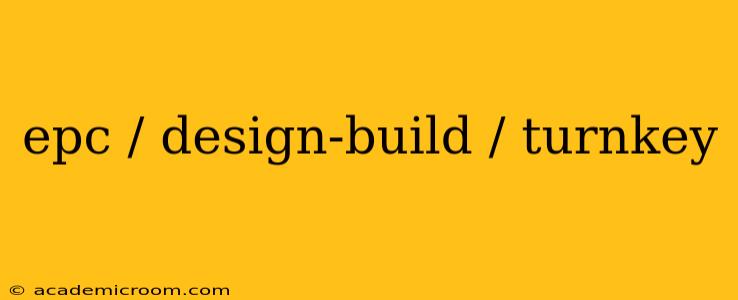The engineering, procurement, and construction (EPC), design-build, and turnkey project delivery methods are all popular choices for complex projects, but they differ significantly in their scope, responsibilities, and risk allocation. Understanding these nuances is crucial for choosing the best approach for your specific needs. This article will break down each method, compare their key features, and help you determine which is the right fit for your project.
What is EPC (Engineering, Procurement, and Construction)?
EPC is a project delivery method where a single contractor takes responsibility for the entire project lifecycle, from engineering and design to procurement of materials and construction. The client provides the contractor with a clear set of requirements and specifications, and the contractor manages all aspects of the project's execution. This approach is particularly well-suited for projects with complex technical requirements or those requiring specialized expertise.
Advantages of EPC:
- Single point of contact: Simplifies communication and coordination.
- Reduced risk for the client: The contractor assumes responsibility for most project risks.
- Faster project completion: Streamlined processes can lead to quicker delivery.
- Cost certainty (potentially): A fixed-price contract can provide predictable costs.
Disadvantages of EPC:
- Higher upfront costs: The contractor's fees can be substantial.
- Less client control: The client has less direct control over the project's day-to-day execution.
- Potential for disputes: Disagreements over specifications or change orders can arise.
What is Design-Build?
Design-build is a project delivery method where a single entity is responsible for both the design and construction of a project. This entity, typically a joint venture of a designer and a contractor, works collaboratively to deliver the project. This approach fosters better communication and integration between the design and construction phases.
Advantages of Design-Build:
- Improved communication and coordination: The design and construction teams work together seamlessly.
- Faster project completion: The overlapping design and construction phases can accelerate the project timeline.
- Value engineering opportunities: The integrated team can identify cost-saving opportunities during the design phase.
- Single point of accountability: The client deals with one entity for the entire project.
Disadvantages of Design-Build:
- Potential for design compromises: The focus on speed might compromise the optimal design.
- Increased risk for the client (potentially): Depending on the contract, the client might bear more risk.
- Limited client input in design: Clients may have less influence on the design process.
What is Turnkey?
A turnkey project is delivered completely finished to the client. The contractor handles everything from initial concept and design to final completion and handover, often including commissioning and training. Essentially, the client receives a "ready-to-use" product or facility. It's often used in projects with standardized designs or repetitive construction.
Advantages of Turnkey:
- Simplicity for the client: Minimal client involvement is required.
- Predictable costs (potentially): Fixed-price contracts can provide cost certainty.
- Faster project delivery: Streamlined processes ensure a quick turnaround.
- Reduced risk for the client (generally): The contractor absorbs significant project risk.
Disadvantages of Turnkey:
- Less client control: The client has limited influence on the design and construction process.
- Potentially higher costs: The contractor's all-inclusive fees can be significant.
- Limited customization: Adapting the project to specific needs might be difficult.
EPC vs. Design-Build vs. Turnkey: Which is Right for You?
The best project delivery method depends on various factors, including project complexity, budget, timeline, and the client's level of involvement.
- Complex projects with high technical requirements: EPC is often preferred.
- Projects requiring strong collaboration between design and construction: Design-build is a suitable option.
- Projects where simplicity and minimal client involvement are prioritized: Turnkey might be the ideal choice.
Ultimately, carefully assessing your project's specific needs and engaging experienced professionals will help you choose the most effective and efficient project delivery method. Remember to thoroughly review contracts and understand the risks and responsibilities involved in each approach.
Frequently Asked Questions
What are the key differences between EPC and design-build?
While both involve a single entity managing a significant portion of the project, EPC focuses on a more defined scope provided by the client, while design-build allows for more collaborative design input from the contractor.
Is turnkey always more expensive than other methods?
Not necessarily. While turnkey projects often incorporate a higher upfront cost due to their comprehensive nature, the overall cost can be comparable or even less than other methods if the project benefits from economies of scale or standardized designs.
Can I combine elements of different project delivery methods?
Yes, it's possible to customize a project delivery approach that blends aspects of EPC, design-build, and turnkey to best suit your specific requirements. This often requires careful negotiation and a clear understanding of the responsibilities of each party involved.
How do I choose the right contractor for my project?
Thorough due diligence is critical. Consider the contractor's experience, expertise, financial stability, and track record on similar projects. Request references and carefully review their proposals and contracts.
